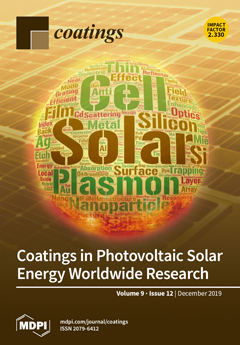Open AccessArticle
Surface Properties of Retrieved Cementless Femoral Hip Endoprostheses Produced from a Ti6Al7Nb Alloy
by
Klemen Avsec, Monika Jenko, Marjetka Conradi, Aleksandra Kocijan, Alenka Vesel, Janez Kovač, Matjaž Godec, Igor Belič, Barbara Šetina Batič, Črtomir Donik, Matevž Gorenšek, Boštjan Kocjančič and Drago Dolinar
Cited by 9 | Viewed by 2635
Abstract
We have investigated new and retrieved cementless hip endoprostheses that prematurely failed due to (i) aseptic loosening, (ii) infection and (iii) latent infection. The aim was to better understand the physico-chemical phenomena on the surfaces and sub-surfaces of the Ti6Al7Nb alloy implant. The
[...] Read more.
We have investigated new and retrieved cementless hip endoprostheses that prematurely failed due to (i) aseptic loosening, (ii) infection and (iii) latent infection. The aim was to better understand the physico-chemical phenomena on the surfaces and sub-surfaces of the Ti6Al7Nb alloy implant. The results of our studies should enable us to distinguish the causes of premature failure, optimize the surface modification, achieve optimal osseointegration and extend the useful lifetime of the implants. The surface properties of the Ti6Al7Nb alloys of the hip-stem endoprostheses (30 retrieved and 2 new) were determined by contact-angle measurements and the average surface roughness. The surface chemistry and microstructure were analysed by scanning electron microscopy (SEM) for morphology, energy-dispersive X-ray spectroscopy (EDS) for the chemistry, and electron back-scatter diffraction (EBSD) for the phase analysis; Auger electron spectroscopy (AES) and X-ray photoelectron spectroscopy (XPS) for the surface chemistry; and electrochemical measurements for the corrosion. The improved wettability of the grit-blasted surface of the Ti6Al7Nb stems after autoclaving was measured, as was the super wettability after oxygen-plasma sterilization. The secondary-electron images showed that the morphology and microstructure of the new and retrieved stems (prematurely failed due to aseptic loosening, infection and latent infection) differ slightly, while the EDS analysis revealed corundum contamination of the grit-blasted surface. We found corundum-contaminated Ti6Al7Nb stem surfaces and sub-surfaces for all the investigated new and retrieved implants. These residues are a potential problem, i.e., third-body wear particles, and probably induce the osteolysis and aseptic loosening.
Full article
►▼
Show Figures





